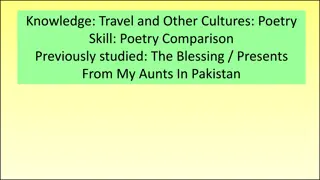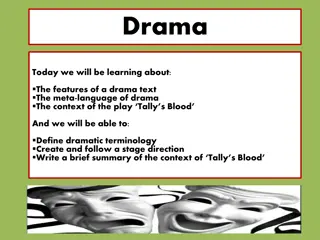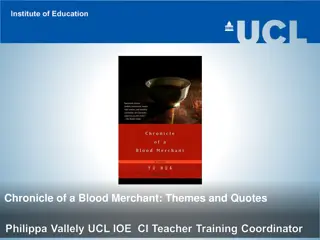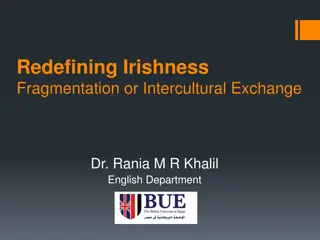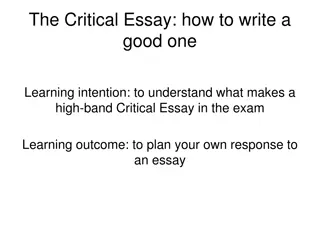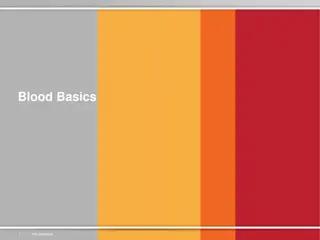Exploring the Themes of Cultural Identity in Tally's Blood
The play "Tally's Blood" by Ann Marie di Mambro delves into the multifaceted themes of cultural identity, racism, integration, and generational relationships within Scottish and Italian communities. Set against the backdrop of Glasgow, the narrative unfolds over two decades, highlighting the challenges faced by individuals of foreign descent and the societal tensions that arise. Through a blend of Glaswegian dialect and Italian influences, the play portrays a poignant reflection on poverty, war, ambition, and the clash of moral standards. It resonates with audiences interested in complex societal dynamics and historical contexts, offering a deep exploration of the evolving landscape of Scotland post-1930s.
Download Presentation

Please find below an Image/Link to download the presentation.
The content on the website is provided AS IS for your information and personal use only. It may not be sold, licensed, or shared on other websites without obtaining consent from the author. Download presentation by click this link. If you encounter any issues during the download, it is possible that the publisher has removed the file from their server.
E N D
Presentation Transcript
Tallys Blood Scottish Set Text
The Title "Tally's Blood" was the unpleasant nickname Scots gave the raspberry sauce that Italian ice-cream- makers put on their produce. In Ann Marie di Mambro's drama, it is also a reference to the suffering of the Scots-Italian community during the second world war.
The Structure The play chronologically covers a period of twenty years. There are large gaps in the time-line: Act One has scenes set in 1936, 1939, 1943 and 1944. Act Two is set eleven years later in 1955. There are 31 scenes, giving the play a cinematic structure. This technique pushes the storyline on quickly, even when there is a break in the time sequence. It builds up a sense of tension. One important character, Luigi, has only a very brief appearance at the beginning of Act One, and is in fewer than half the scenes in Act Two. One influential character Massimo s father does not appear at all but we hear a great deal about him and recognise his influence on his sons and daughter-in-law. Two nationalities are involved Scottish and Italian. Differences in their national characteristics are important but there are similarities, too religion, family ties, hardships.
The Setting Seven scenes are set in Italy, 24 in Scotland. A large number of locations are specified, indoors and outdoors. One even involves characters climbing a ladder and going in through a window. The play covers a 20-year period from 1936 to 1955.
Language The language is realistic mostly that of working class Glaswegians. Massimo and, particularly, Rosinella occasionally introduce Italian phrases or speech patterns. In the scenes set in Italy, the characters sometimes use Italian. In one scene the playwright uses the device of having her characters speak in the Glaswegian dialect although they are supposedly speaking Italian. This device enables the audience to understand the dialogue though Hughie cannot. The children use vocabulary and sentence structure appropriate to their age.
Relevance/Themes The play is all about Scotland and Scottish society but seen through the eyes of Rosinella, an Italian. The poverty of 1930s Scotland. A lack of employment. War. Ambition. The dependence of young people on their parents. Integration of foreign nationals. The difference between the clear moral standards of the Italian community and the perceived laxity of the Scots. Racism on both sides, as shown by the mob on the one hand and Rosinella s contempt for Scottish men on the other.
Target Audience Scots, especially, perhaps, those of foreign blood. Those who are concerned about how Scotland has developed since the Thirties the diversity of influences from the past, the conflicting pressures of different ethnic backgrounds, the changing relationships within society. Young people, who will identify with the problem of relationships between generations. Those with an interest in history. Those with an interest in religion. Those with an interest in racial integration.
Italian Family Tree Daddy Pedreschi (paid-rays-key) Rosinella s sister (deceased) Rosinella marries Luigi Ianelli Loo-eej-ay yan-ell-ee) Massimo Franco Uncle and aunt of Lucia Ianelli (Loo-che-a yan-ell-ee)
Scottish Family Tree Adam Devlin married Mrs Devlin Hughie Devlin Six other children Bridget Devlin
As you read You should make notes on each of the characters as you read the play You can do this at the end of each scene or when prompted to do so by your teacher You can make your notes in the form that best suits you though your teacher will give you some examples Quotes are important but not the only information that you will need. You must be able to refer to specific incidents and techniques too
Example - Massimo Born in Italy but moved to Scotland when he was young Hard-working: Your Uncle Massimo had to make a lot of ice cream to get you that nice dress. Loves Rosinella: That s ma heart, Rosie. And he s beating just for you. Own business
Characters In pairs take a scene each and find quotations or stage directions that show your chosen character s thoughts and feelings. (In a small class, pairs could have two scenes each.) There is also evidence of dramatic irony that could be discussed. This could be developed into a wall chart highlighting the changes in Rosinella or in Hughie and Lucia s relationship. An artistic learner could draw the character and frame them with quotations.
Task - Character Critical Reading Section 2 (critical essay) Answers to questions on Drama should refer to the text and to such relevant features as characterisation, key scene(s), structure, climax, theme, plot, conflict, setting Choose a play in which there is a character who is important in relation to the theme of the play. Referring to appropriate techniques, explain how this character affects our understanding of this theme.
Task - Character Choose a character from the play Make notes on why they are important. You can use bullet points or a mind map Identify at least three quotes to support your answer Be prepared to feedback to the rest of the class
Rosinella Pedreschi Nobody loves their families like the Italians Married Family is everything Fiercely protective Pushes people away No limits to what she will do Controlling Becomes cold and bitter Fiercely nationalistic Prejudiced Selfish Tries to shift the blame Realises the error of her ways Does a complete U-turn But it s alright for me. I m Italian. It s one thing to play around with them, so long as you marry your own kind. If you knew what I ve been through.
Massimo Pedreschi Shopkeeper Married Born in Italy Moved to Scotland as a wee boy Happy in Scotland Shows compassion and consideration Hard working Own Business Not got an easy relationship with father Big hearted Kind Shocked by internment Loves his wife deeply Becomes distanced from his wife as she becomes cold and bitter Becomes reconciled to his wife as she changes Everyone likes you I used to think I had two countries, now I feel I ve got nowhere. Just you have it, Luigi
Franco Pedreschi Born in Scotland Works in father s shop 2nd generation Italian In his 20 s at opening of play Can dance well Hot-blooded Italian male Loving Faithful Loves Bridget Signs up to fight for Britain before Italy enters the war Dies in war fighting for the British Defies family pressure Proud of Italian heritage Sees himself as British I won t go all the way, I promise, I wouldn t want you to regret it. I cannie be expected to spend my whole life working from morning till night in a wee pokey shop.
Bridget Devlin Just a wee Scottish tart for him to practice on. Hughie s sister Oldest of 8 Catholic Late teens at start of play Head of the family financially Mother cannot cope Supportive of others Loves Franco Gets pregnant Has abortion Encourages Hughie to follow his dream Spinster Bus conductress Mid 30 s at end of play You should be going to the dancing, get yourself a girlfriend.
Hughie Devlin Bridget s brother 5 years old at start of play Father killed in mining accident Seen in the play aged 9 Hard working Grows fond of Lucia Falls in love with Lucia Determined Tried to become Lucia s blood brother Is scared his love is not reciprocated Follows Lucia to Italy Declares his love for Lucia Elopes with Lucia I have waited years Years for Lucia. Blending into the background, knowing my place- och it s just you.
Luigi Ianelli Lucia s father Rosinella s brother-in-law Farmer Widow at start of play Five sons at start of play One daughter at start of play Remarries and has a baby Lazy Greedy Sponger Wants his daughter to marry well Covets his neighbour s land Looking for anything he can get When you ve finished the clothes, you ve to come up to the house. Ma wife s going to teach you to clean a chicken. Giachetta scozzese (jack-ate-a scott-says-ay)
Lucia Ianelli Adopted by Aunt and Uncle Brought to Scotland aged 2 Spoiled Manipulative Learns about prejudice and racism at school Falls in love with Hughie Devlin Returns to Italy Elopes with Hughie Oh, who s that lovely wee girl. Oh, who s that lovely wee girl. She s not going to Scozzia. She s not marrying any Scozzese. She s staying here.
Task Key Scene Critical Reading Section 2 (critical essay) Answers to questions on Drama should refer to the text and to such relevant features as characterisation, key scene(s), structure, climax, theme, plot, conflict, setting Choose a play in which there is a key scene. Briefly describe what happens in this scene then, by referring to dramatic techniques, go on to explain why the scene is important to the play as a whole.
Act One, Scene Two Lucia posing for Rosinella and Massimo in new a new dress Massimo is affectionate with Rosinella and teases Lucia Mood changes when Lucia is asked to take her dress off and becomes hysterical The adults fail to take a firm line with her Lucia wins Shows Lucia s manipulative side which is further developed throughout the play Establishes the bond between Rosinella and Massimo and how different they are Reveals how happy they are to have Lucia in their lives Franco is important as he mentions that Lucia may not always be there, something the Pedreschi family face later in the play Character Conflict Mood Theme Dramatic Techniques Importance Brief Summary
Other Key Scenes to Consider Act One Scene 3 Scene 5 Scene 12 Scene 15 Act Two Scene 1 Scene 2 Scene 7 Scene 12








